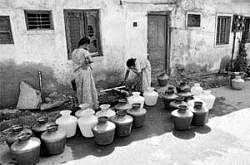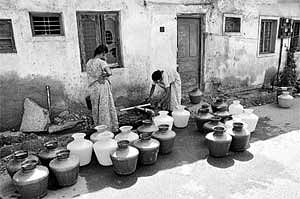

A fight breaks out as student Vikas Dagar jostles with dozens of men, women and children to fill buckets from a truck that brings water twice a week to the village of Jharoda Kalan on the outskirts of New Delhi.
Three thousand kilometres away, near Xi’an in central China, power-plant worker Zhou Jie stands on the mostly dry bed of the Wei river, remembering when he used to fish there before pollution made the catch inedible.
Dagar and Zhou show the daily struggle with tainted or inadequate water in India and China, a growing shortage that the World Bank says will hamper growth in the world’s fastest-growing major economies. It also is pitting water-intensive businesses such as Intel Corp’s China unit and bottling plants of Coca-Cola against growing urban use and the 1.6 billion people in China and India who rely on farming for a living.
“Water will become the next big power, not only in China but the whole world,” Li Haifeng, vice president at sewage-treatment company Beijing enterprises water group ltd, said. “Wars may start over the scarcity of water.”
About 2.4 billion people live in ‘water-stressed’ countries such as China, according to a 2009 report by the Pacific Institute, an Oakland, California-based nonprofit scientific research group. Water scarcity and pollution reduce China’s gross domestic product by about 2.3 per cent, the World Bank said in a 2007 report.
Doubling demand
Water demand in the next two decades will double in India to 1.5 trillion cubic meters and rise 32 per cent in China to 818 billion cubic meters, according to a research report. China’s 1.33 billion people each have 2,117 cubic meters of water available per year, compared with 1,614 cubic meters in India and as much as 9,943 cubic meters in the US, according to the FAO of the United Nations. The 1.2 billion people in India, where farmers use 80 per cent of available water, will exhaust their fresh-water supplies by 2050 at the current rate, the World Bank estimates.
For Dagar, 21, and the 200 other villagers in Jharoda Kalan, that dearth is already a daily fact of life. “This is for our drinking and cooking,” he said, pointing to four bucketfuls he won from the fight. “I’ve been waiting for the past hour.”
Southwest China had its worst drought in a century this year, prompting Premier Wen Jiabao to say that the country would face a test to meet its grain output target. The drought affected 24 million people and 16 million acres of arable land, Liu Ning, vice-minister of water resources, said.
India’s farmers are awaiting the start of the rainy season this month after the weakest monsoon in more than three decades last year cut rice output by as much as 10 per cent, according to the agriculture ministry.
China, with 20 per cent of the world’s population and 7 per cent of its fresh water, has contaminated 70 per cent of its rivers and lakes, while half the cities have polluted groundwater, according to the World Bank. By 2030 China will have a supply shortfall of 201 billion cubic meters unless the government takes steps to control demand.
The Wei river was rated ‘severely polluted’ by the government in 2009, according to a report in state-run ‘China Daily’. That’s forced Zhou to fish instead in pools near the river. The river level has dropped by about three-quarters in some places in the past decade, he said.
“China can solve this problem in a way that creates economic value as opposed to economic cost,” said Joerss. “There is tremendous, though largely untapped, opportunity to meet China’s enormous need for water resources by focusing on better managing demand.”
Investments in technologies to ease China’s water deficit are expected to reap 131 billion yuan ($19 billion) in profit a year, according to the McKinsey report.
In March, a panel from the southern Indian state of Kerala recommended suing Coca-Cola bottler Hindustan Coca-Cola beverages pvt for Rs 2.16 billion ($48 million) damages for contamination and ‘serious depletion’ of water in Palakkad. In an April 26 e-mail, the company denied that its plant, shut since March 2004, depleted or tainted the town’s water.
“Water and water treatment is going to be the next growth story after power,” said M S Unnikrishnan, managing director at Pune, India-based Thermax, which makes water-recycling equipment. Thermax shares have almost doubled to Rs 670 on the Bombay Stock Exchange in the past year.
“This decade belongs to food and water,” said Vijay Bhambwani, CEO of online stock researcher Bsplindia.com. He holds shares in Ion Exchange. “I am quite bullish on water stocks. Next year onwards they will start outperforming the market by a factor of two.”
Uneven distribution
In both China and India, fresh water reserves are unevenly distributed. Northern China, with cities including Beijing, has less than a fifth of the country’s fresh water and almost half the population.
Former Chinese leader Mao Zedong, who began trying to address the water issue as early as the 1950s, conceived the south-north water diversion project to carry water along three routes from the Yangtze river to the Yellow river. Construction began in 2003 and has cost more than $5.8 billion so far. The completion date has been pushed back four years to 2014 as costs and environmental concerns mount.
Government proposals in India were no less ambitious. Former Prime Minister Atal Bihari Vajpayee in 2003 appointed a panel to assess building a series of dams and canals that would link rivers to control floods and curtail shortages. The Rs 5 trillion plan was shelved after protests from environmentalists.
Instead, India has concentrated on conservation. The government has made it mandatory for new houses and condominiums in cities to collect rainwater in an effort to curb a decline in groundwater levels. The Congress-led coalition is also implementing a plan to replenish about a million lakes, ponds and water tanks. About 60 per cent of India’s arable land still depends on the annual monsoon.
“Water availability has declined to such an extent that many parts of India today face a drought-like situation,” said Sushmita Sengupta, research associate at the Centre for Science and Environment in New Delhi.
The two countries’ plans don’t always mesh. When China dammed the Mekong, the largest river flowing into Southeast Asia, Thailand, Vietnam, Cambodia and Laos all called for greater cooperation to prevent droughts and floods. China also plans a dam in Tibet on the Yarlung Zangbo, the highest major river in the world, which flows into India as the Brahmaputra.
The project would give Beijing control of the water supply to more than 90,000 sq km of land controlled by India while China claims sovereignty.
“Water scarcity is probably one of the biggest risks for investors in China and India,” said Lucy Carmody, executive director of Singapore-based investor advisory firm Responsible Research. “There is a lot of potential for border conflicts.”